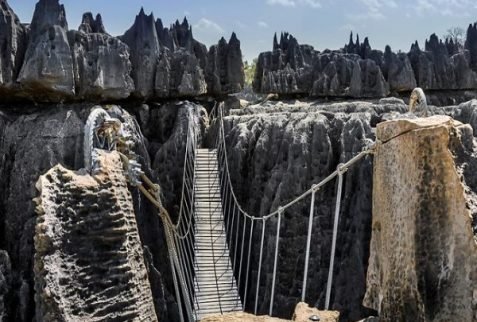Tsingy de Bemaraha National Park
Lorem ipsum dolor sit amet, consectetur adipiscing elit. Cras sollicitudin, tellus vitae condimentum egestas, libero dolor auctor tellus, eu consectetur neque elit quis nunc.
The spectacular Tsingy de Bemaraha National Park, a city of limestone, located on the west coast of Madagascar, approx. 8 hours of winding track from Morondava. Tsingy is the Malagasy word for “where one cannot walk barefoot” and the almost impenetrable labyrinth of limestone needles justifies this name. Until 1998 this area was not on tourist routes. The northern section is an integral reserve, so tourists cannot enter the area.
The park can be visited from April to mid-November due to its remoteness and the rain that flood the plains from December to Mars.
A small level of fitness is required to visit the Big Tsingy, you will be required to climb small ladders, crawl few meters and pass through very narrow (30/35 cm) limestone walls.


Fauna
Up to 11 species of lemurs can be spotted, including Decken’s sifaka and the rufous brown lemur. Other mammals that can be seen are the small falanouc and the ring-tailed mongoose. In the various caves, many bats can be encountered. More than 100 species of birds have currently been cataloged within the National Park, including the endangered Madagascar fish eagle and the crested ibis. The 45 reptiles and amphibians found here are all endemic.
Flora
The flora has a high rate of local endemism. The western part is mainly covered by dry deciduous forests, which are particularly well adapted to the changing climatic conditions of the area. The eastern section is made up of grassy savannas and lowland bushes. Inside the canyons we find small areas of dense tropical and lian forests, since it is very humid among the high tsingy formations. The canyons, gorges, undisturbed forests, lakes and mangrove swamps of the reserve show a surprising wealth of fauna and flora, many of which have not yet been registered.
